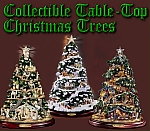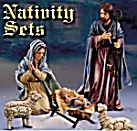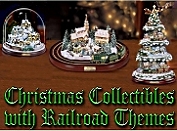|
Mummers -
from Family Christmas OnlineTM
During the middle ages and early renaissance, European festivals, and holidays were often marked by groups of "commoners" dressed in outrageous costumes entertaining crowds and begging for money from street corners to city squares to banquet halls. It's believed that the "mummers," as they were called, performed silly dances, plays, and songs. They may have drawn their inspiration from the Morality Plays that were written by medieval clergy to present moral lessons to crowds that had gathered on special occasions. Unlike the carefully scripted Morality Plays, the contents of the mummers' "shows" seem to have been passed on orally from one locale or generation to the next. In addition, the mummer's performances seem to have been ribald and included any amount of horseplay. In some cases, the "horseplay" was literal - a few versions included a wooden horse with snapping jaws that would get laughs by pretending to charge the crowd. 
Other Ancient Cosplay
In those days, there was other costume play as well. For example on "Plough Day" (the first Monday after Epiphany), local farmers would don disguises and do a sort of trick-or-treat with a plow. Anyone unwilling to make a financial contribution ran the risk of having a furrow cut through their yard or flower garden.
Several European countries had traditions related to mumming. But they were seldom documented in much details. What we know about mummers and similar ancient "cosplay"  today comes from various references in medieval and renaissance writings and drawings. This includes an account of a 14th-century mummer's performance in the court of Edward III, as well as the illustrated manuscript to the right, now in the Bodleian Library. today comes from various references in medieval and renaissance writings and drawings. This includes an account of a 14th-century mummer's performance in the court of Edward III, as well as the illustrated manuscript to the right, now in the Bodleian Library.
Mummers and British Theatre
Although mumming never really entered the "mainstream" of British theatre, folks were definitely aware that it existed. A Midsummer Night's Dream (>1596) shows Shakespeare's fascination with the dynamics of an uneducated troupe getting together to put on a show for the fun of it. (Yes, Troilus and Cressida was a "masque," not a mummery, but when the troupe's leader is Bottom, the difference is not so great as one might think.)
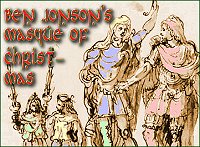 In 1616, English author Ben Jonson produced a comical Christmas "Masque" for the court of King James I, in which he incorporated so many costumes and so much comedy that that his contemporary critiques called it a "mummery" rather than a masque. At least one of Jonson's themes - "Christmas" introducing his "children" - appears in later amateur mumming plays, but it's hard to tell whether Jonson had borrowed this theme from earlier mummers or the later mummers borrowed the theme from Jonson. In 1616, English author Ben Jonson produced a comical Christmas "Masque" for the court of King James I, in which he incorporated so many costumes and so much comedy that that his contemporary critiques called it a "mummery" rather than a masque. At least one of Jonson's themes - "Christmas" introducing his "children" - appears in later amateur mumming plays, but it's hard to tell whether Jonson had borrowed this theme from earlier mummers or the later mummers borrowed the theme from Jonson.
Mind the Gap
Ironically, two centuries later, when Washington Irving wanted to introduce mummers into a fictitious tale of Christmas at an English gentleman's home, he used examples from Jonson's play, not from any actual mumming performances. Why the disconnect? Irving, in 1820, was trying to recreate the way Christmas had been celebrated in 1620, and he may never have seen an actual mumming performance. The Puritan-run Commonwealth outlawed all such displays about 1649, and mumming had been discontinued or driven "underground" - punishable by jail time - about seventy years before Irving wrote. There are hints that the practice was coming back, but there was hardly an unbroken line of tradition from the 19th century back to the sixteenth.
Mummers Reemerge
The first post-Commonwealth reference to mumming is a poetic allusion to one of the most common characters, in an English poem that was ostensibly written in 1738, but not published until 1770. The poem describes its hero as showing more decorum than the "Christmas Mummer," also called "England's Heroe." The phrase "England's Hero" always refers to St. George, who figures prominently in certain mummer narratives. In case readers missed the reference, the 1770 editor added the footnote:
At Christmas are (or at least very lately were) Fellows wont to
go about from House to House in Exeter a mumming ; one
of whom, in a (borrow'd) Holland Shirt, most gorgeously
be-ribbon'd, over his Waistcoat, (&. flourishing a Faulchion,
yery valiantly entertains the admiring Spectators thus:
Oh ! here comes I Saint George, a Man of Courage bold
And with my Spear, I winn'd three Crowns of Gold.
I slew the Dragon and brought him to the Slaughter;
And by that very means I married Sabra, the beauteous
King of Egypt's Daughter
Peter Millington, owner of the Master Mummers web page, has done done extensive research on mummers and related folk plays of the British Isles. He has also gathered all the credible mummer scripts he could find into one place, dated and annotated. Considering the number of variants he lists, and the common understanding that the mummer plays originated in the Middle Ages, it is surprising that oldest lines of any mummer play on record only go back to 1770.
Millington proposes that, prior to the Puritan Commonwealth, the mummers didn't put on plays at all, but entertained by clowning, juggling, and the like. This is in contrast to the "majority view," that the mummers did put on plays, but they depended exclusively on oral transition. So when mumming went "underground," the "scripts" - such as they were - went underground as well.
However you explain the lack of earlier mummer play scripts, the fact is that mumming was reemerging by the late 1700s, and began to become popular by 1830, peaking just before World War I.
Mumming since 1830
When you scan through Millington's database of mumming plays, you'll notice how many of the scripts were first recorded after 1830. When you scan through British literature that describes mumming, you'll notice how many of the descriptions were written after 1860. It is clear that, although they may claim to be talking about ancient times, they're actually describing mumming as it occurred from about 1830 on.
Examining the scripts themselves, you'll also notice several patterns, as though there were about four common naratives (and a few others that are all but lost to us). To me, diversity within most of the groups implies that they could be older, possibly pre-Commonwealth relics passed down, in spite of persecution, through families, guilds, village story-tellers, and other oral channels. The key phrase is "could be." Because when we begin analyzing the plays themselves, all we have to work with are the nineteenth-century records.
The basic patterns could be broken down in the following classes:
- The "Peace Egg" narrative has nothing to do with peace, or eggs, for that matter. This apparently started out as an Easter ("Pache") play, so it is sometimes called "Pache Egg," and sometimes "Pace Egg," depending on regional dialects. Although there are many variations, the most common versions go like this: A hero, usually St. George, brags - in rhyming couplets - that he has accomplished wonders and will take all comers. If the company owns a dragon costume, St. George takes on the dragon first. Otherwise the dragon-killing is simply listed among his accomplishments in his opening speech.
Next, a series of adversaries - also introducing themselves in rhyming couplets - attack St. George one by one. These may include such worthies as the "Prince of Palatine," the "Turkish Knight," "Bold Slasher," and the King of Egypt. St. George kills them all, then regrets one of the killings. A doctor is called for. At this point the mock-heroic tone of the play shifts to a comedy routine. The Doctor is quizzed about his qualifications, giving ludicrous answers. Then he gives a comic speech bragging of his skills. Finally, he produces a pill or bottle that restores whichever victim who has been chosen for restoration. In one case he restores the dragon so St. George can kill him again, then restores one of the fallen knights. The show may conclude with a sword dance, then a call for contributions. Or they may skip the sword dance and go right to the begging.
- The Old Horse plays involve a wooden horse that is reportedly "on its last legs." The mechanical contraption used for this show often includes a full-body wooden puppet with snapping jaws. It is generally worn by one of the company. The kind of puppets used are sometimes called "hobby horses."
After the company recites a long poem about how the horse is good for nothing but leather and glue, some legermain occurs, and the horse is restored to its youthful, jaw-snapping vitality. Then the troupe asks for money. In many old lithographs, you'll see the wooden horse with the snapping jaws, even when the rest of the players seem to be dressed for one of the other plays. This could mean that the troupe had multiple shows in their repertoire, or simply that they brought the "horse" along for general hijinks.
- The Wooing/Recruiting Sergeant/Plough plays are usually associated with Plough Day. They usually involve a "fool" (the narrator and comic of the piece), a farmer, a young girl, and a recruiting sergeant. In one of the more common versions, the farmer wins the girl's heart, but then the recruiting sergeant gets him to join the army or navy. So the girl marries the fool. Then the troupe asks for money. It is possible that this narrative or something like it was associated with the older Plough Day hijinks described earlier.
- The Robin Hood and the Tanner plays retell a typical Robin Hood story - Robin and the tanner argue over some slight, then have a battle of walking-sticks. Sometimes Little John gets into the act as well. If there is a death, you can expect the Doctor from the Peace Egg to show up with more-or-less the same comedy routine. The ending may include a dance with the walking sticks. The last act will always involve a plea for money.
Robin Hood also appears as a warrior in variants of the Peace Egg.
- Several other narratives must have existed, because some of the characters are still with us, names and all. But their stories are lost, or too fragmentary to credibly reconstruct.

Where's "Christmas"?
Despite Washington Irving's comparison of Ben Jonson's Christmas Masque to the mummers he describes, none of these plays revolve around Father Christmas and his children, as Jonson's script does. Some of the plays start out with "Christmas" or "Father Christmas" announcing his arrival and starting to introduce his children (Mince Pie, Misrule, and other personified merriments). Occasionally he uses phrases that are likely inspired by Jonson's. But "Christmas" is soon pushed aside by people with swords, plows, horses, or sticks. My sense is that the "Christmas" character has been spliced into narratives that had got along just fine without him.
Who is the Doctor?
A character that gets more traction in these stories is the Doctor, who can be called in to raise the dead in any of these plays - even plays where a fight to the death seems strangely out of place. The interpolation of these resurrection scenes into so many mumming plays once led critics to claim that they could trace the stories' resurrection themes all the way back to ancient cultures. To me that's a tall claim when you can't even trace most of the stories back past 1830. Few folks hold to that contention these days, however.
Peter Millington has noted that the "Quack Doctor" turns up in most versions of most of these narratives. To Millington, that implies that the Doctor is the central character of all of these narratives. Millington even sorts the scripts he has collected by whether or not the Doctor appears.
My sense is that all of these narratives existed before the Doctor, and he was added in later. I would even propose that his lines come from a broadside or other printed source - that would explain why plays that diverge widely in most other respects have nearly the same text once the Doctor appears. But why would he become so "universal"? Perhaps, once he appeared on the scene, his routine became a crowd favorite, and audiences came to expect his character and his comedy routine.
By the way - and I'm not going to claim this signifies anything - even in later years when mummer troupes began to dress more uniformly, with most characters in ribboned shirts and pointed hats or some such, the Doctor retains his characteristic appearance - usually a black suit with a black brimmed hat, such as a top hat or derby. 
The Fool
Another character who appears in more than one narrative is the Fool, who is usually anything but. He may be costumed like a jester, and he often gets the funniest lines. But his function is grander than that. Often he acts as the MC, narrating, introducing other characters, and otherwise moving the action along. Sometimes he participates in the dialogue with the other characters. In some of the Wooing plays, he gets the girl. 
I will mention the Lord of Misrule mainly because Jonson and Irving both saw fit to include him. In the broader context, the Lord of Misrule was a renaissance holiday tradition in which someone willing to lead entertainments for all twelve days of Christmas would "rule" in the king's place making silly "laws," hosting parties, and the like - often at his own expense. The Lord of Misrule custom was probably discontinued during Henry VIII's reign, but the character lived on for a time in masques and mumming plays. In some cases he is the fool, although sometimes they both appear in the same play. 
The Dragon
For some reason, I have a soft spot in my heart for the Dragon. He is restricted to the Peace Egg cycle, and he doesn't always appear in those - sometimes he is just a line in St. George's list of accomplishments. When the dragon does appear, he is nearly always St. George's first challenger. In many scripts, his speeches start with: "Who calls so angry and so loud?" - a line reminiscent of the Apothecary's in Romeo.
Other Characters, Other Narratives
Mumming troupes often included other characters such as a witchy woman and a hunch-backed old man, who often have names assigned. They may have had their own narratives at one time, though now they're lucky to have a few lines in other people's stories.
In addition there were many minor recurring characters like "Johnny Jack," "Beelzebub" and "Devil Doubt," whose chief roles seem to have been coming in at the end and starting the collection.
 Costumes Costumes
In the middle ages we know that the costumes varied widely within each troupe, depending on the role being played. They were elaborate and diverse. According to Millington, the mummers weren't wearing masks as much as they were wearing such elaborate headgear that their faces tended to be obscured.
Lithographs of early 19th-century British mumming troupes show costumes that represented the characters. For example the "Turkish Night" in the drawing to the right wears a turban and carries a scimitar. But somewhere in the mid-19th-century a shift toward a troupe "uniform" began.
 Perhaps it started with St. George, who, as early as 1770 was described wearing a white shirt covered with ribbons on the outside of his waistcoat. By 1900 many mumming troupes seemed to dress everyone but the Doctor in such garb. The headgear for some troupes also standardized, often around a white pointed cap. Each troupe had a separate look, but within the troupe there was growing uniformity. At least until mumming went largely "on hold" again, about the time the "War to End All Wars" began. Perhaps it started with St. George, who, as early as 1770 was described wearing a white shirt covered with ribbons on the outside of his waistcoat. By 1900 many mumming troupes seemed to dress everyone but the Doctor in such garb. The headgear for some troupes also standardized, often around a white pointed cap. Each troupe had a separate look, but within the troupe there was growing uniformity. At least until mumming went largely "on hold" again, about the time the "War to End All Wars" began.
Reviving versus Reenacting
The 19th-century mummers seem to have been trying to keep an old custom from dying out altogether. Today's mummers are aware that they are "reenacting" something from the past - in the same way that U.S. civilians sometimes dress in blue and gray uniforms and "reenact" classic Civil War battles. You can pretend all you want, but you're not going to bring back the Civil War (thank God.) Nor does anyone really expect a mumming revival to sweep the nation the way it did just two centuries ago. But knowing that actually gives today's mummers freedom. If they wish, they can pick up where the early 20th century mummers left off, or they can attempt to recreate any period of mumming that appeals to them, even the medieval era that has been largely lost to us. Consequently, among practicing mummers today, you will see costumes of all periods, and hear scripts that vary from strictly traditional to including modern humor.
Related Movements
Many other cultures have festivals in which troupes dress up in outrageous costumes to entertain the crowdes, especially at and around holidays. One tradition even calls itself "mummers."
In the U.S., "mummers parades" focus on the costumes, with various clubs competing to have the most elaborate or striking costumes in each parade. The Philadelphia Mummer's parade, on New Years Day each year, is by far the best known and probably the oldest. As you can see by the pictures below, though the parade started out with great diversity of costume within each club, by the 1920s, each club was going to a more uniform appearance.
 |

|
| 1888 |
1920s |
One odd footnote is that many of the Philly mumming clubs used to march in blackface, ostensibly in an attempt to recognize the (tenuous) African sources of the parade elements. Blackface mummers became politically incorrect in the 1960s and 1970s - as they should have. Most of the clubs seem to have got over it.
The performing aspect of this "mumming" is pretty much restricted to brief routines that can be staged during momentary pauses in the parade route, though. Since it began, the parade has added many "clubs" from other cultural backgrounds, including German, French, and Italian, all of which seem to have related traditions.
In New Orleans, the competing organizations that turn out for the Mardi Gras turn in a similarly spectacular show, although I'm told that its less "family-friendly" than the Philadelphia parade.
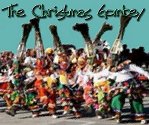 In Bermuda, costumed "Gombey" troupes march on Boxing days and other holidays, playing drums and staging faux battles. (Our short story pages include a story about this called "The Christmas Gombey.") In Bermuda, costumed "Gombey" troupes march on Boxing days and other holidays, playing drums and staging faux battles. (Our short story pages include a story about this called "The Christmas Gombey.")
In fact, whatever your cultural heritage, if you go back far enough, you're likely to find a similar tradition you can celebrate, especially if you can get other folks willing to dress up in silly clothes and put on silly performances for your friends and neighbors.
Mumming Misused
Of course, just about anything, no matter how wholesome in itself, can be misused for evil. Some folks claim that the medieval Plough Day participants wore "mummer-style" disguises so they wouldn't get in trouble for the vandalism they were threatening and occasionally performed. In Newfoundland, mumming was outlawed for over a century because assaults by people dressed as mummers culminated in the death of a beating victim.
The worst case of of evil people borrowing elements of mummery for nefarious purposes is probably the Klu Klux Khan. Not only do the Klan uniforms seem to be influenced by the mummer uniforms of the late 1800s, and early 1900s, members also called their leaders "knights" and "dragons," the most prominent mumming characters. That's not to say that Klansmen are "evil mummers," only that they borrowed elements that leant pageantry and disguise to their unspeakably evil activities.
I wouldn't dream of "throwing out the baby with the bathwater," or claiming that mumming is evil because evil people have "borrowed" some of its elements for hellish purposes. After all, the vast majority of today's mummers are well-meaning people who simply want to entertain strangers and who enjoy doing it in the fellowship of like-minded performers. But no organization or group or hobby is entirely invulnerable to "hinky" stuff happening in the groups' name.
If you get involved in any mummer-related activities, please make certain that you keep everything you do positive, so your "mummery" is seen as a positive force, worth preserving for generations to come.
Conclusion
I started this article because a few of our other articles referred to mummers, and I wanted to give some context. Of course there's a lot more to this than I thought there would be. With the revival of renaissance festivals, Boar's Head feasts, Morris Dancing (in Britain), and even "flash-mobbing," it's not hard to see why mumming is attracting participants today.
Whether this article gets you perusing sripts and making costumes or simply helps you enjoy the anachronistic chaos of the next mummer presentation you see, we hope it helps you enjoy a much misunderstood holiday tradition.
- Paul Race.
To return to the Family Christmas OnlineTM Home Page, click here.
|

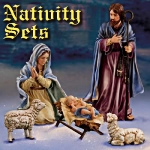

|


 In Bermuda, costumed "Gombey" troupes march on Boxing days and other holidays, playing drums and staging faux battles. (Our short story pages include a story about this called "The Christmas Gombey.")
In Bermuda, costumed "Gombey" troupes march on Boxing days and other holidays, playing drums and staging faux battles. (Our short story pages include a story about this called "The Christmas Gombey.")



